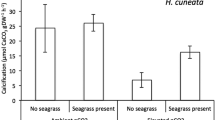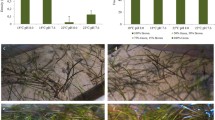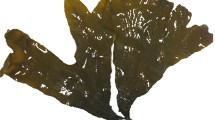Abstract
Coastal areas face high variability of seawater pH. Ocean acidification (OA) and local stressors are enhancing this variability, which poses a threat to marine life. However, these organisms present potential phenotypic plasticity that can offer physiological and structural tools to survive in these extreme conditions. In this study, we evaluated the effects of elevated CO2 levels and consequent pH reduction on the physiology, anatomy and ultrastructure of the seagrass Halodule wrightii. A mesocosm study was conducted in an open system during a 30-day experiment, where different concentrations of CO2 were simulated following the natural variability observed in coastal reef systems. This resulted in four experimental conditions simulating the (i) environmental pH (control condition, without CO2 addition) and (ii) reduced pH by − 0.3 units, (iii) − 0.6 units and (iv) − 0.9 units, in relation to the field condition. The evaluated population only suffered reduced optimum quantum yield (Y(II)), leaf width and cross-section area under the lowest CO2 addition (− 0.3 pH units) after 30 days of experiment. This fitness commitment should be related to carbon concentration mechanisms present in the evaluated species. For the highest CO2 level, H. wrightii demonstrated a capacity to compensate any negative effect of the lowest pH. Our results suggest that the physiological behaviour of this primary producer is driven by the interactions among OA and environmental factors, like irradiance and nutrient availability. The observed behaviour highlights that high-frequency pH variability and multifactorial approaches should be applied, and when investigating the impact of OA, factors like irradiance, nutrient availability and temperature must be considered as well.








Similar content being viewed by others
References
Anthony KRN, Kleypas JA, Gattuso JP (2011) Coral reefs modify their seawater carbon chemistry-implications for impacts of ocean acidification. Glob Change Biol 17:3655–3666
Arnold T, Mealey C, Leahey H, Miller AW, Hall-Spencer JM, Milazzo M, Maers K (2012) Ocean acidification and the loss of phenolic substances in marine plants. PLoS One 7:1–10
Beer S, Wetzel RG (1982) Photosynthetic carbon fixation pathways in Zostera marina and three Florida seagrasses. Aquat Bot 13:141–146
Beer S, Koch E (1996) Photosynthesis of marine macroalgae and seagrass in globally changing CO2 environments. Marine Mar Ecol Prog Ser 141:199–204
Bozzola JJ, Russell LD (1999) Electron microscopy: principles and techniques for biologists. Jones and Bartlett Publishers, Boston, p 670
Britton D, Cornwall CE, Revill AT, Hurd CL, Johnson CR (2016) Ocean acidification reverses the positive effects of seawater pH fluctuations on growth and photosynthesis of the habitat-forming kelp, Ecklonia radiata. Sci Rep 6:26036
Caldeira K, Wickett ME (2005) Ocean model predictions of chemistry changes from carbon dioxide emissions to the atmosphere and ocean. J Geophys Res 110:1–12
Campbell JE, Fourqurean JW (2013) Mechanisms of bicarbonate use influence the photosynthetic carbon dioxide sensitivity of tropical seagrasses. Limnol Oceanogr 58:839–848
Challener RC, Lisa LR, James BM (2016) Variability of the carbonate chemistry in a shallow, seagrass-dominated ecosystem: implications for ocean acidification experiments. Mar Freshw Res 67:163–172
Chapin FS III, Sala O, Burke IC, Grime JP et al (1998) Ecosystem consequences of changing biodiversity. Bioscience 48:45–52
Cheng SH, Moore BD, Seemann JR (1998) Effects of short and long-term elevated CO2 on the expression of ribulose-1.5.Biphosphate carboxylase/oxygenase genes and carbohydrate accumulation in leaves of Arabidopsis thaliana (L.) Heynh. Plant Physiol 116:715–723
Cummings ME, Zimmerman RC (2003) Light harvesting and the package effect in the seagrasses Thalassia testudinum banks ex König and Zostera marina L.: optical constraints on photoacclimation. Aquat Bot 75:261–274
DenHartog C (1970) The sea-grasses of the world. North Holland, Amsterdam, p 275
Doney, SC, Fabry, VJ, Feely RA, Kleypas JA (2016) Ocean Acidification: The Other CO Problem. Wash. J. Envtl. L. & Pol'y 6, 213
Duarte C, Hendriks I, Moore T, Olsen Y, Steckbauer A, Ramajo L, Carstensen J, Trotter J, McCulloch M (2013) Is ocean acidification an open-ocean syndrome? Understanding anthropogenic impacts on seawater pH. Estuar Coast 36:221–236
Duarte CM (2002) The future of seagrass meadows. Environ Conserv 29:192–206
Duarte G, Calderon EN, Pereira CM, Marangoni LF, Santos HF, Peixoto RS, Bianchini A, Castro CB (2015) A novel marine mesocosm facility to study global warming, water quality, and ocean acidification. Ecol Evol 5:4555–4566
Epron D, Liozon R, Mousseau M (1995) Effects of elevated CO2 concentration on leaf characteristics and photosynthetic capacity of beech (Fagus sylvatica) during the growing season. Tree Physiol 16:425–432
Fabricius KE, Langdon C, Uthicke S, Humphrey C, Noonan S, De'ath G, Okazaki R, Muehllehner N, Glas MS, Lough JM (2011) Losers and winners in coral reefs acclimatized to elevated carbon dioxide concentrations. Nat Clim Chang 1:165–169
Fahn A (1982) Plant anatomy. Pergamon Press, Oxford, p 544
Feely RA, Sabine CL, Hernandez-Ayon JM, Ianson D, Hales B (2008) Evidence for upwelling of corrosive “acidified” water onto the continental shelf. Science 320:1490–1492
Ferreira C, Horta A, Almeida GM, Zitta CS, Oliveira ME, Gueye MB, Rodrigues AC (2015) Anatomical and ultrastructural adaptations of seagrass leaves: an evaluation of the southern Atlantic groups. Protoplasma 252:3–20
Findlay HS, Artioli Y, Moreno Navas J, Hennige SJ, Wicks LC, Huvenne VAI, Woodward EMS, Roberts JM (2013) Tidal downwelling and implications for the carbon biogeochemistry of cold-water corals in relation to future ocean acidification and warming. Glob Chang Biol 19:2708–2719
Gahan PB (1984) Plant histochemistry and cytochemistry: an introduction. Academic Press, London, p 301
Garrard SL, Beaumont NJ (2014) The effect of ocean acidification on carbon storage and sequestration in seagrass beds; a global and UK context. Mar Pollut Bull 86:138–146
Gautier C (2008) Oil, water and climate: an introduction. Cambridge University Press, New York, p 366
Genty B, Briantais JM, Baker NR (1989) The relationship between the quantum yield of photosynthetic electron transport and quenching of chlorophyll fluorescence. Biochim Biophys Acta 990:87–92
Greiner JT, McGlathery KJ, Gunnell J, McKee BA (2013) Seagrass restoration enhances “blue carbon” sequestration in coastal waters. PLoS One 8:1–8
Gruber N, Hauri C, Lachkar Z, Loher D, Frölicher TL, Plattner GK (2012) Rapid progression of ocean acidification in the California current system. Science 337:220–223
Hall-Spencer JM, Rodolfo-Metalpa R, Martin S, Ransome E, Fine M, Turner SM, Rowley SJ, Tedesco D, Buia MC (2008) Volcanic carbon dioxide vents show ecosystem effects of ocean acidification. Nature 454:96–99
Heminga M, Duarte CM (2000) Seagrass ecology. Cambridge University Press, Cambridge, p 298
Hofmann GE, Barry JP, Edmunds PJ, Gates RD, Hutchins DA, Klinger T, Sewell MA (2010) The effect of ocean acidification on calcifying organisms in marine ecosystems: an organism-to-ecosystem perspective. Annu Rev Ecol Evol 41:127–147
Hofmann GE, Smith JE, Johnson KS, Send U, Levin LA, Micheli F, Paytan A, Price NN, Peterson B, Takeshita Y, Matson PG, Crook ED, Kroeker KJ, Gambi MC, Rivest EB, Frieder CA, Yu PC, Martz TR (2011) High-frequency dynamics of ocean pH: a multi-ecosystem comparison. PLoS One:6–e28983
Invers O, Zimmerman RC, Alberte RS, Pérez M, Romero J (2001) Inorganic carbon sources for seagrass photosynthesis: an experimental evaluation of bicarbonate use in species inhabiting temperate waters. J Exp Mar Biol Ecol 265:203–217
IPCC (2007) Climate change 2007: the physical science basis. In: Solomon S, Qin D, Manning M, Chen Z, Marquis M et al (eds) Contribution of Working Group I to the Fourth Assessment Report of the Intergovernmental Panel on Climate Change. Cambridge University Press, Cambridge, UK and New York, USA
IPCC (2013) Climate change 2013: the physical science basis. In: Stocker TF, Qin D, Plattner GK, MMB T, Allen SK et al (eds) Contribution of Working Group I to the Fifth Assessment Report of the Intergovernmental Panel on Climate Change. Cambridge University Press, Cambridge, UK and New York, USA
Jiang ZJ, Huang XP, Zhang JP (2010) Effects of CO2 enrichment on photosynthesis, growth, and biochemical composition of Seagrass Thalassia hemprichii (Ehrenb.) Aschers journal of integrative. Plant Biol 52:904–913
Klughammer C, Schreiber U (2008) Complementary PS II quantum yields calculated from simple fluorescence parameters measured by PAM fluorometry and the saturation pulse method. PAM Application Notes 1:27–35
Koch M, Bowes G, Ross C, Zhang XH (2013) Climate change and ocean acidification effects on seagrasses and marine macroalgae. Glob Chang Biol 19:103–132
Kroeker KJ, Kordas RL, Crim RN, Singh GG (2010) Meta-analysis reveals negative yet variable effects of ocean acidification on marine organisms. Ecol Lett 13:1419–1434
Larkum AWD, Drew E, Ralph P (2006) Photosynthesis and metabolism in seagrasses at the cellular level. In: Larkum AWD, Orth RJ, Duarte CM (eds) Seagrasses: biology, ecology and conservation. Springer, The Netherlands, pp 323–345
Last M, Luta G, Orso A, Porter A, Young S (2008) Pooled ANOVA. Comput Stat Data Anal 52:5215–5228
Lin J, Jach ME, Ceulemans R (2001) Stomatal density and needle anatomy of Scots pine (Pinus sylvestris) are affected by elevated CO2. New Phytol 150:665–674
Lüthi D, Le Floch M, Bereiter B, Blunier T, Barnola JM et al (2008) High-resolution carbon dioxide concentration record 650,000-800,000 years before present. Nature 453:379–382
Masle J (2000) The effects of elevated CO2 concentrations on cell division rates, growth patterns, and blade anatomy in young wheat plants are modulated by factors related to leaf position, vernalization, and genotype. Plant Physiol 122:1399–1416
Matesanz S, Valladares F (2014) Ecological and evolutionary responses of Mediterranean plants to global change. Environ Exp Bot 103:53–67
Maxwell K, Johnson GN (2000) Chlorophyll fluorescence: a practical guide. J Exp Bot 345:659–668
Melzner F, Thomsen J, Koeve W, Oschlies A, Gutowska MA, Bange HW, Körtzinger A (2013) Future ocean acidification will be amplified by hypoxia in coastal habitats. Mar Biol 160:1875–1888
Mousseau M, Saugier B (1992) The direct effect of increased CO2 on gas exchange and growth of forest tree species. J Exp Bot 43:1121–1130
O'Brien TP, Feder N, Mccully M (1964) Polychromatic staining of plant cell walls by toluidine blue O. Protoplasma 2:367–373
Orth RJ, Carruthers TJB, Short FT, Dennison WC, Duarte CM, Fourqurean JW, Heck KL Jr, Hughes AR, Kendrick GA, Kenworthy WJ, Olyarnik S, Waycott M, Williams SL (2006) A global crisis for seagrass ecosystems. Bioscience 56:987–996
Ow YX, Uthicke S, Collier CJ (2016a) Light levels affect carbon utilisation in tropical seagrass under ocean acidification. PLoS One 11:e0150352
Ow YX, Vogel N, Collier CJ, Holtum JAM, Flores F, Uthicke S (2016b) Nitrate fertilisation does not enhance CO2 responses in two tropical seagrass species. Sci Rep 6
Palacios S, Zimmerman RC (2007) Response of eelgrass Zostera marina to CO2 enrichment: possible impacts of climate change and potential for remediation of coastal habitats. Mar Ecol Prog Ser 344:1–13
Phillips RC, Menez EG (1988) Seagrasses. Smithsonian Institution, Washington, p 104
Pritchard SG, Peterson CM, Prior SA, Rogers HH (1997) Elevated atmospheric CO2 differentially affects needle chloroplast ultrastructure and phloem anatomy in Pinus palustris: interactions with soil resource availability. Plant Cell Environ 20:461–471
Quarmby C, Allen SE (1989) Organic constituents. In: Allen SE (ed) Chemical analysis of ecological materials. Blackwell Scientific Publications, London, pp 160–200
Radoglou KM, Jarvis PG (1990) Effects of CO2 enrichment on four poplar clones. I. Growth and leaf anatomy. Ann Bot 65:617–626
Radoglou KM, Jarvis PG (1992) The effects of CO2 enrichment and nutrient supply on growth morphology and anatomy of Phaseolus vulgaris L. seedlings. Ann Bot 70:245–256
Reusch TB, Boyd PW (2013) Experimental evolution meets marine phytoplankton. Evolution 67:1849–1859
Reynolds ES (1963) The use of the lead citrate at high pH as an electron-opaque stain in electron microscopy. J Cell Biol 17:208–212
Ritchie RJ (2006) Consistent sets of spectrophotometric chlorophyll equations for acetone, methanol and ethanol solvents. Photosyn Res 89:27–41
Ritchie RJ (2008) Universal chlorophyll equations for estimating chlorophylls a, b, c ed and total chlorophylls in natural assemblages of photosynthetic organisms using acetone, methanol or ethanol solvents. Photosynthetica 46:115–126
Russell BD, Connell SD, Uthicke S, Muehllehner N, Fabricius KE, Hall-Spencer JM (2013) Future seagrass beds: can increased productivity lead to increased carbon storage? Mar Pollut Bull 73:463–469
Sabine CL, Tanhua T (2009) Estimation of anthropogenic CO2 inventories in the ocean. Annu Rev Mar Sci 2:175–198
Scherner F, Barufi JB, Horta PA (2012) Photosynthetic response of two seaweeds species along an urban pollution gradient: evidence of selection of pollution-tolerant species. Mar Poll Bull 64:2380–2390
Scherner F, Pereira CM, Duarte G, Horta PA, Castro CB, Barufi JB, Pereira SMB (2016) Effects of Ocean Acidification and Temperature Increases on the Photosynthesis of Tropical Reef Calcified Macroalgae. PloS one 11, e0154844
Schulz KG, Zeebe RE, Riebesell U (2009) CO2 perturbation experiments: similarities and differences between dissolved inorganic carbon and total alkalinity manipulations. Biogeosciences 6:145–2153
Schwarz AM, Bjork M, Buluda T, Mtolera H, Beer S (2000) Photosynthetic utilisation of carbon and light by two tropical seagrass species as measured in situ. Mar Biol 137:755–761
Short FT, Coles RG (2001) Global seagrass research methods. Elsevier Science, Amsterdam, p 473
Sims DA, Seeman RJ, Luo Y (1998) Elevated CO2 has independent effects on expansion rates and thickness of soybean leaves across light and nitrogen gradients. J Exp Bot 49:583–591
SINDA (2013) Historical data: meteorological and agrometeorological. Available: <http://sinda.crn2.inpe.br/PCD/SITE/novo/site/index.php>. Acessed: November 2013
Spurr AR (1969) A low-viscosity epoxy resin embedding medium for electron microscopy. J Ultrastruct Res 26:31–43
Unsworth RK, Collier CJ, Henderson GM, McKenzie L (2012) Tropical seagrass meadows modify seawater carbon chemistry: implications for coral reefs impacted by ocean acidification. Environ Res Lett 7:1–9
Uku J, Beer S, Björk M (2005) Buffer sensitivity of photosynthetic carbon utilisation in eight tropical seagrasses. Mar Biol 147:1085–1090
Walker DI, Kendrick GA, McComb AJ (2006) Decline and recovery of seagrass ecosystems—the dynamics of change. In: Larkum AWD, Orth RJ, Duarte CM (eds) Seagrasses: biology, ecology and conservation. Springer, The Netherlands, pp 551–565
Wong SC (1990) Elevated atmospheric partial pressure of CO2 and plant growth. II. Nonstructural carbohydrate content in cotton plants and its effect on growth parameters. Photosyn Res 23:171–180
Yemm EW, Willis AJ (1954) The estimation of carbohydrates in plant extracts by anthrone. Biochem J 57:508
Zeebe RE (2012) History of seawater carbonate chemistry, atmospheric CO2, and ocean acidification. Annu Rev Earth Planet Sci 40:141–165
Zimmerman RC (2006) Light and photosynthesis in seagrass meadows. In: AWD L, Orth RJ, Duarte CM (eds) Seagrasses: biology, ecology and conservation. Springer, The Netherlands, pp 303–321
Acknowledgments
The authors acknowledge the Coral Vivo Project and its sponsors Petrobras and Arraial d’ Ajuda Eco Parque. The authors also acknowledge the staff of the Electron Microscopy Central Laboratory (LCME), Plant Anatomy Laboratory (LAVEG), Morphogenesis and Plant Biochemistry Laboratory (LMBV) and Phycology Laboratory (LAFIC) of the Federal University of Santa Catarina, Florianopolis, Santa Catarina, Brazil. The authors also thank the journal reviewers and native expert Walter Rich IV for the improvements in the manuscript.
Funding
This work was supported by grants from Boticario Foundation; FAPESC—Foundation Support Research and Innovation in the State of Santa Catarina; CNPq—National Council for Scientific and Technological Development; Capes-Higher Education Personnel Improvement Coordination; REBENTOS—Habitat Monitoring Network Coastal Benthic and ProspecMar-Islands—Sustainable Prospecting in Ocean Islands: Biodiversity, Chemistry, Ecology and Biotechnology; Rede Coral Vivo and REDEALGAS; Brazilian Research Network on Global Climate Change, FINEP/Rede CLIMA Grant Number 01.13.0353-00 and FAPESP—Foundation Support Research and Innovation in the State of São Paulo (FAPESP, 2014/00012-1).
Author information
Authors and Affiliations
Corresponding author
Additional information
Handling Editor: Néstor Carrillo
Electronic supplementary material
Online Resource 1
(PDF 90 kb)
Online Resource 2
(PDF 94 kb)
Online Resource 3
(PDF 120 kb)
Online Resource 4
(PDF 196 kb)
Online Resource 5
(PDF 86 kb)
Online Resource 6
(PDF 166 kb)
Online Resource 7
(PDF 12 kb)
Rights and permissions
About this article
Cite this article
Schneider, G., Horta, P.A., Calderon, E.N. et al. Structural and physiological responses of Halodule wrightii to ocean acidification. Protoplasma 255, 629–641 (2018). https://doi.org/10.1007/s00709-017-1176-y
Received:
Accepted:
Published:
Issue Date:
DOI: https://doi.org/10.1007/s00709-017-1176-y




